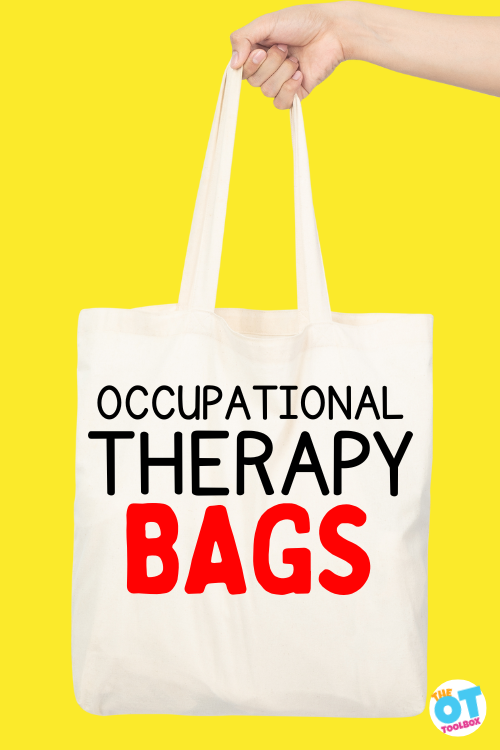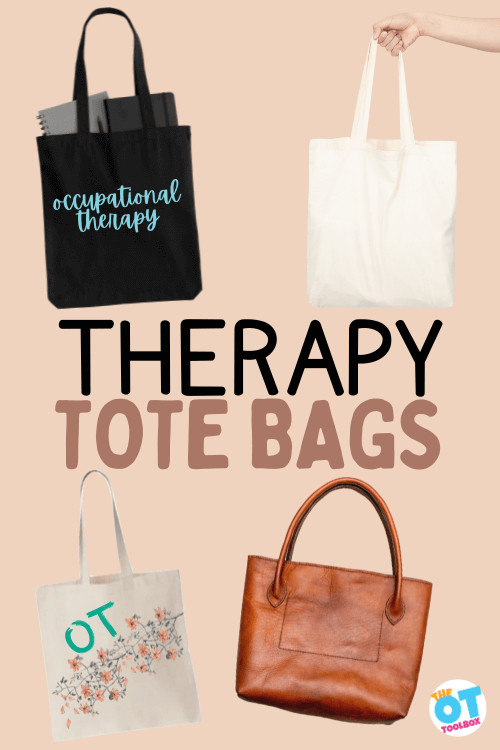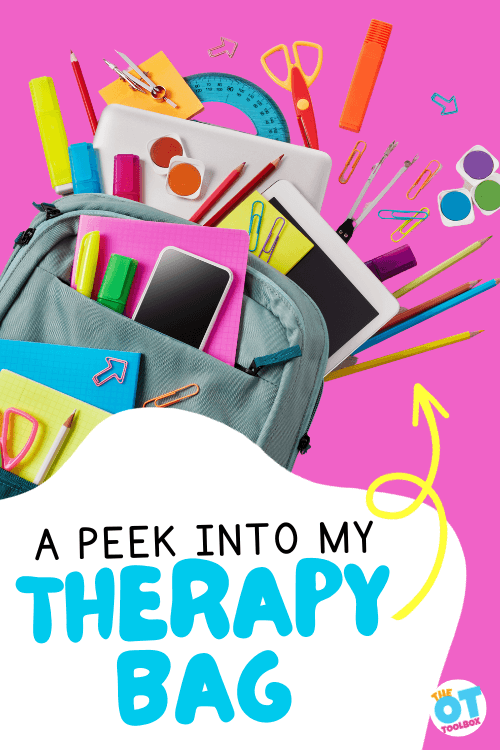Whether you are returning to a new school year, or working on your therapy tools, it is time to revisit the therapy bag. Depending on your work environment, caseload, and setting, your therapy bags may look different. For the therapy provider just getting started in the school setting, or for new grad OTs, the question comes up quite often: What is the best therapy bag to get?! In this post we will start by looking at different types of therapy bags people are using, then dive into the kinds of items therapists put in their “toolbox”. You may even want to consider a therapy bag as an occupational therapy gift for the OT or OTA in your life!

These therapy supply bags might even be a great gift for the occupational therapy provider in your life!
The Best therapy bags
The best therapy bag for you depends on your work space, the number of schools you might visit in a day, or the therapy setting (clinic, home setting, early intervention, etc.). Consider these questions to find the therapy bag that best meets your needs…
- What kind of therapy bag do you like best? Are you a backpack kind of therapist or a rolling cart therapy provider?
- Do you work out of the trunk of your car grabbing a handful of stuff as you go? A therapy backpack or pull cart might work for you.
- Do you feel like you need to carry your entire office everywhere you go? A rolling suitcase or therapy cart might work.
- Are you fortunate enough to have everything at your fingertips, needing only a couple of things in your pockets? A therapy tote bag might best suit your needs.
Let’s take a look at the various types of therapy bags and the pros and cons of each. (Amazon affiliate links are included below.)
the Therapy Backpack
A backpack is the go-to bag for many therapy providers. It is easy to carry, ergonomically designed to carry the weight of the bag and contents, and comes with lots of pockets for storing your tools.
There are thousands to choose from, starting with the classic Swiss Army brand, the Jansport with its great warranties, Lands End and LLBean for their level of quality and more.
These links below are Amazon affiliate links in which commissions are earned from qualifying purchases.
- In the past I bought fancy trendy backpacks that were pretty, but not practical. Bags like this Vera Bradley design (commissions earned) were irresistible. That was until my pens leaked into them, I sat them on the dirty floor, they were covered in who knows what, and the mysterious sticky stuff showed up at the bottom of the bag. While these are washable, they are not practical.
- Now my preferred therapy backpack (commissions earned) is more practical, but less showy. It has over 89,000 positive reviews on Amazon. It has lots of pockets for storing tools and toys. It is missing the chest strap, but generally my bag is not overloaded unless I am taking it on vacation.
- This Lovelook backpack (commissions earned) is very popular as a therapy backpack. It boasts many pockets and is trendy looking, however it does not open very wide, meaning all your stuff is going to end up at the bottom somewhere. It looks awkward to carry, especially if you have a heavy load or wear it frequently.
- This great therapy bag from Coowoz (commissions earned) has a lot of space in it. It opens flat so you can see what is in the bag. The shoe compartment can hold baggies of stuff, or your lunch and snacks. It comes in a couple of different sizes. This therapy backpack is a cross between a piece of luggage and a backpack.
- The Army Style backpack, (commissions earned) while looking very utilitarian, is functional and sturdy. Check out all the pockets! It is also designed to be ergonomically correct with the chest and waist straps. I love that this one is called the Assault Pack. (commissions earned) Sometimes it feels like therapists are fighting a battle every day.
Kawaii Therapy Backpack
If you are set on fun over function, a Kawaii therapy backpack is a fun style. Check them out here. (commissions earned) The Kawaii backpacks are sweet and practical.
Kids will love to see the therapy tools they may use that day peeking through the windows of the backpack.
Roller Therapy backpacks
In recent years as I age, and my therapy supplies enlarge, I am leaning more toward a therapy bag on wheels. These are especially helpful if you travel on foot between schools, across a large campus, or throughout a big hospital or facility.
These types of therapy supply packs can vary from a roller backpack to a carry-on suitcase. For the therapy provider that works in school hallways or even supply closets, this can be a great bag to carry all of the therapy supplies from space to space.
- The Rockland Rolling Backpack (commissions earned) is most cost effective. You might be able to replace this one every year if needed. I like that it still has handles for carrying up and down stairs or in tight spaces. Not sure how rugged and sturdy it is, and it only boasts a couple of pockets.
- This J World New York style (commissions earned) is a little more costly but looks sturdier. It comes in tons of fun designs and colors. It has a few pockets and nice big wheels for traveling.
- Check out the giant wheels on this one! (commissions earned) If you travel in rough terrain, this bag might be for you.
- Matein makes a roller bag (commissions earned) that is functional. It is high in price, but looks sturdy. It has tons of pockets for all your tools and can be converted to a regular backpack.
Alternative rolling therapy bags
There are other options beyond your basic luggage rolling bag, too. These therapy bags are nice for the added features.
- Rolling Duffle bags (commissions earned) have always been popular. They are not as sleek as other bags, but have lots of room and pockets. The added space means you can tote around extra supplies like wiggle cushions, alternative seating options, self-regulation tools, etc.
- If you do not have a lot of things to carry in your therapy bag, a rolling laptop case (commissions earned) might be the way to go. They are more professional looking than a backpack or duffle bag if that matters where you work. This design has many pockets for storing items. It comes with carry handles and is not going to be as easy to tote as a backpack.
the Rolling Suitcase
In the past year I have switched over to a rolling suitcase. I like that it is sturdy and big. What I do not like is the lack of pockets. I find myself adding baggies of similar items into my case and searching for items.
Another benefit of the rolling suitcase therapy bag is that it’s easier on the back to pull, and the wheels are designed for someone who needs to walk through busy airports, or from school building to school building!
- Us Traveler (commissions earned) has a basic budget friendly design. It comes with an additional bag for fidgets, manipulatives, snacks, or a grab and go bag. It does have some pockets and a large opening for your bigger tools.
- Pediatric therapists (commissions earned) will love these cute bags! They are not huge, but will be a big hit with your kids.
- Scooter ride on case (commissions earned) – while I am not sure if these come in my size, I would love one! Imagine scooting all over your work place. Plus, it doubles as a sensory therapy tool, too!

Therapy Tote Bags
There are many therapy tote bags on the market, too. I love the fun advertisement for occupational therapy, physical therapy, or speech therapy that some of these offer!
These links below are Amazon affiliate links in which commissions are earned from qualifying purchases.
- A Utility tote is a nice compact bag with many pockets. If you do not have a long distance to carry it, and it is not too heavy, it is a practical therapy bag. This “Nurses bag” has 21 pockets!! The trouble with too many pockets is remembering which one it is in!
- If you are looking for something personal and crafty, there are tons of therapy bags listed. They come in all different shapes and sizes, can be personalized, and are fun to use. While not as practical as a rolling tote, they are great for carrying a few items back and forth.
Therapy Crate
A rolling therapy crate or therapy box is nice because you can cart around paper, worksheets, and various therapy tools and materials.
These links below are Amazon affiliate links in which commissions are earned from qualifying purchases.
- The collapsible crate is becoming more popular. These are great for toting large items, or lots of toys at once. No pockets, so stuff might get jumbled in there. FYI it does not fit in the trunk of a Mini Cooper, so it was out for me.
- This hardshell bag is a functional sturdy bag. It does not have wheels and must be hand carried. This looks professional and has a large pocket for big items. Not many pockets on this one.

The occupational therapy supplies in my therapy bag are geared toward younger elementary, preschool, and high school OT students.
What is in your therapy bag?
Now that you have selected the best bag for you (I am seriously eyeing a new roller backpack), you have to fill it with occupational therapy tools, and other stuff. I love the “other stuff” because I am always amazed at what I find I have stuffed in my OT bag.
There are many items that may make up your occupational therapy equipment list because therapy interventions depend so much on the needs of each individual. That’s why switching out items in your therapy bag (whatever the type) is so essential.
Last year it was a random pair of socks, seven chapsticks, enough pens to write a novel, and a couple of valentines. If you are like me, your therapy bag is constantly changing, depending on the day and caseload.
Let’s start with the basic standard occupational therapy tools to fill your therapy bag:
- Mini zippered pouches (commissions earned) – these are a must have if you use small items. They are great for sorting items for easy retrieval. Fill them with school supplies, one for grippers, prizes, fidgets, snacks, or personal items. You can also use pencil cases or plastic Ziplock bags for storage
- Personal items – as noted above, lip balm is in my bag. You can pack items such as bandaids, feminine hygiene products, wipes, hand sanitizer, aspirin, makeup, hair spray, stain remover, ear buds, hair ties, extra reading glasses (had to make a quick Walmart run early one morning), or whatever you feel you might need. I prepare for work as if I am living on a desert island where nothing is available.
- Office supplies – pens, pencils, white out strip, paperclips, tape, scissors, envelopes, sharpies, labels, and a stapler. If you have an actual office, you might not need to travel with all these office supplies, but at least have a pen handy
- Planner (commissions earned) I like this hourly one. Even if you do online scheduling, it is nice to glance at a paper calendar and have a back-up. This way you have at least two sources to document your visits
- School supplies – these are the standard supplies you use in therapy: scissors, glue, glue stick, paper, pencils, crayons, dot markers, etc. You can get a shower caddy to carry these or one of the zippered pouches
beyond the basic therapy bag supplies
These items can be used to create your own set of Occupational Therapy Activity Toolkits. Then, you can switch things out to keep the kids on your caseload motivated.
- Fine motor therapy supplies – in the school system as well as some other settings you need a grab bag selection of pencil grips to try with your kids, different kinds of scissors (loop, self-opening, tiny ones), tongs, pom poms, a dressing board, pennies in a container, putty, beads and string, stickers, shaving cream, pop tubes, play dough, clothespins, and other small items to work on fine motor skills. Not sure what to add to your bag? You can make your own DIY Fine Motor Toolkit.
- Small sensory items – you never know when a teacher or other professional is going to ask if you have ones they can use at this very moment. It is nice to have them handy. Small fidgets, calm strips, rubber bands, theratubing, a mini sensory bin, and different types of pencil toppers are great
- Larger therapy items – hopefully you are not carrying too many large items on a daily basis. These might include: a rocker board, wiggle cushion, slant board, wipe off board, weights, headphones, or anything you use consistently. These items might fit best in the collapsible crate
- Tools – some therapists need goniometers, grip and pinch meters, screwdrivers, and other items to work with their clients
- Games and puzzles – large games like Connect 4, Candyland, Pop the Pig, Kerplunk and other classic games are great, but take up a lot of room. There are now mini versions of several popular games. (commissions earned)
- Snacks – as a therapist you are never ever certain you are going to get a lunch break. Having snacks like granola bars, trail mix, candy, breakfast bars, and crackers is a good idea to keep on hand. If you motivate your students with candy or food, you will want to put some small items in your bag for them too.
- Paper activities – while the bag is full of fun stuff, do not forget the fine motor paper tasks. Pack different lined paper, printed activities, color/cut/glue pages, mazes, puzzles, etc. I try and plan the week ahead by adding my printables to the bag that I can use all week. Each week I rotate printables. The OT Toolbox has some great themed kits like this A-Z Bug Themed activity set. Search on the site for fine motor kits, or shop in the OT Toolbox store.
Therapy Bag tools change depending on setting
There is not going to be a one sized fits all for the therapy bag. Whether it is the type of bag you carry, or what you put in it.
Homebased pediatric therapists might have blocks, teething rings, stacking rings, and other primary toys. A hand therapist will have tools specific to that trade. The school system therapy bag will vary depending on the age and type of students you work with.
Therapy providers with multiple schools might find they have a different tote for each school.
One thing that helps with using a therapy bag of any kind, is staying organized and planning. I can not tell you how many mornings I run around the office grabbing random things to throw into my bag, or dig around the bottom of the bag looking for a red crayon. It is those weeks that I try and carve out a little time to reorganize the bag and get myself on track for the next week.
All this talk of therapy bags has me wanting to order a new one for this school year! I have my eye on a roller backpack this year, and am tempted by the scooter one if it fits.

Victoria Wood, OTR/L is a contributor to The OT Toolbox and has been providing Occupational Therapy treatment in pediatrics for more than 25 years. She has practiced in hospital settings (inpatient, outpatient, NICU, PICU), school systems, and outpatient clinics in several states. She has treated hundreds of children with various sensory processing dysfunction in the areas of behavior, gross/fine motor skills, social skills and self-care. Ms. Wood has also been a featured speaker at seminars, webinars, and school staff development training. She is the author of Seeing your Home and Community with Sensory Eyes.






